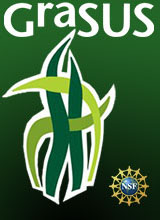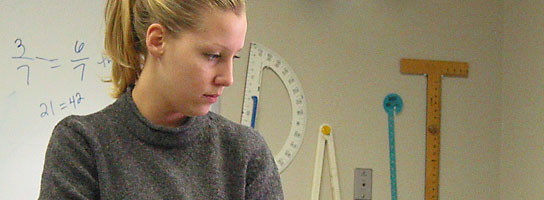|
Lesson Plans, Activities and Units:
|
|
|
GraSUS-II Fellows and teachers develop and modify instructional artifacts throughout the course
of the year. This section represents a sample of some of those artifacts that have been created
or modified for use in the classroom. Artifacts are aligned with Local, state (North Dakota or
Minnesota), and/or National Standards.
|
|
|
Lesson Plans:
- Chemistry
- Water Quality Parameters and Testing
- Students will first learn about why
water quality is important. Then they will gain an understanding of pH, temperature,
color, turbidity, conductivity and dissolved oxygen as they are related to water
quality. Students will apply this knowledge by testing different water samples.
These values will be compared with other water quality information throughout the
region, nation or world. Students will have a broad understanding of why we study
water quality and how it relates to chemistry. (Content Level-High School Chemistry.
Time-One class period to go over the water quality parameters and one class period to
test water quality in various samples)
- The Investigation of Enzymes in Raw Potato Soup
- The objective of this
activity is a summative assessment of the students covering the wide range of topics
covered in the AP chemistry course and how they are able to apply them to a problem of
biological significance. This will also be a continuation of a formative assessment of
their laboratory skills. (Content Level-High school AP chemistry. Time:
Introduction-10 minutes, Reading assignment, Pre-quiz, Homework, Lab activity-1.5 class
periods, Data work-up-1.5 class periods, Post-test-20 minutes)
- Earth Science
- GIS and North Dakota
- By the completion of this lesson, the students should
develop a new method of map visualization along with a more complete understanding of
topographic features. Students will learn how to use ArcView 9.x software and will be
able to add data to a digital map. Students will also learn how to read contour lines
and determine stream patterns commonly found in North Dakota. In addition, the
students will discover the use of Google Earth as a fun and exciting way to explore
their world. (Content Level-8th Grade Earth Science. Time-3 total class periods)
- Mars and the ABC book
- Mars and The ABC Book-Upon the completion of this lesson, the
students will be able to look at geologic images, or geomorphic features, and
understand how these features form. The students will learn what types of things to
look for, how formations are created, and why Mars is so interesting to scientists here
on Earth. (Content Level-8th Grade Earth Science. Time-2 total class periods)
- Engineering and Technology
- Marvels of Chinese Engineering: Three Gorges Dam.
Information Source: Nine Marvels of Chinese Engineering. Williamsburg, VA: Learning Enrichment, Inc., 2004.
- Students will be able to exercise research skills for a particular topic using
library resources like internet, books, references, magazines, and pamphlets.
- Students will be able to apply researched information to support shared opinions
of given topic.
- Students will be able to compile and write down thoughts to critical questions
about real world issues.
- Students will be able to exercise communication skills with fellow students in a
debate manner about particular topic at hand.
- Enforces the use of credible sources to support opinions, importance of good
communication skills, and the ability of thinking critically.
(Content Level-Middle and High School Science. Works well with small classes or small
groups in large classes. Time-1-2 class periods)
- Environmental Science
- Radio Telemetry
- Topic: How biologists track animals, obtain population estimates, and discern movement behavior using various forms of
technology.
- Students will be exposed to technology used in wildlife science
- Students will gain experience in applying technology to novel ideas for investigation
- Students will develop skills in working in groups to solve a problem
(Content Level-Environmental Science. Time-2 Class Periods)
- Life Science
- Contemporary Evolution
- Genes & Harvest. Topic: A lesson on how contemporary evolution can occur through the process of selective harvest.
- Students will learn about the consequences of selective harvest
- Students will examine genetic concepts of small populations
- Students will test how quickly populations can become genetically constrained
- Students will hypothesize how their results apply to other animals
(Content Level-High School Biology. Time- Two 50 min class periods)
- Mathematics
- Probability and Odds
- A presentation and hands on activity for students which
covers theoretical probability, experimental probability, and odds. (Content Level-8th
Grade Mathematics. Time-2 class periods, plus homework and posttest.)
- Surface Area and Volume
- Using these hands on activities, the objectives of
this project are to make students familiar with measurements. Students should be able
to quickly approximate the volume of different objects accurately. Students should
know how to compute surface area accurately. Students should be able to apply these
formulas to various contexts outside the classroom. (Content Level: High School
Pre-Algebra, lower level Geometry Time: Less than one class period)
- Fractions in Action
- Students will become aware of why their hypotheses for
adding and subtracting fractions are incorrect by comparing them with the measurements.
Students will be able to quickly compare two fractions with different denominators.
Students will use their knowledge about least common multiple to quickly find a common
denominator. Students will use their knowledge about greatest common factor to quickly
reduce a fraction to lowest terms. (Content Level-First-time experience with adding and
subtracting fractions. Time-1 class period with possible out of class time, if necessary)
- Physics/Physical Science
- The "Thrill" of Physics
- Topic: Projectile Motion, General Motion.
- Students will correctly apply equations of motion to a rolling/falling projectile.
- Students will be able to identify reasons for error between theoretical calculations and assumptions and the actual
projectile.s motion.
- Students will apply steps of the problem-solving process; decide what data needs to be collected and how to apply it.
|
|


